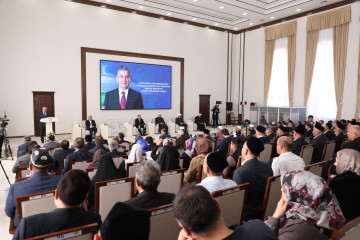
Creed of Mu’tazila: Formation and Approaches
The diversity of opinions in the history of Islam, the interpretation of the content of the verses of the Qur’an, and the hadiths from their point of view, the first attempts to approach them within the framework of philosophical content are related to the activities of the Mu’tazilites. Therefore, while some written sources, especially in Western studies, recognize them as rationalists, followers of the freedom of thought, Ahl al-Sunnah sources refer to them as a misguided, misleading group of Muslims.
Mu’tazila is associated with the names such as Wasil ibn Ata (699-748) and Amr ibn Ubayd (699-761), active members of Hasan Basri’s school (642-728) in Basra during the time of the Umayyad caliph Hisham ibn Abdul Malik. Imam Azam expressed a strong opinion about Wasil ibn Ata and accused him of blasphemy. Although Wasil ibn Ata and the leader of the Qadaris, Ma’bad, were disciples of Hasan al-Basri and attended his scientific meetings, they eventually opposed him and founded their independent school.
The School of Mu’tazila is the first successor of the Jahmiyya and Qadariyya sects, although they disagree with them in some respects. Their views on the subject of the will are noteworthy. This is because the Mu'tazilites, like the Qadaris, believe that man is free to do whatever he wants, and that it is up to him to do what he wants. The views of Abu Hasan ibn Ahmad ibn Abd al-Jabbar (d. 415 AH), a brilliant representative of the Mu’tazila school of thought, who is known as the “Judge of the judges”, are especially important in his book Al-Mughni fi Abwab al-Tawhid wal Adl.
Some written sources state that the Muitazıla sect appeared sometime before Wasil ibn Ata and that Ibn Ata received his views from Abu Hashim ibn Muhammad ibn Hanafiya and his brother Hasan ibn Muhammad ibn Hanafiya (d. 716). Wasil ibn Ata, unlike them, propagated this idea, which was widespread among Muslims. “Wasil ibn Ata became acquainted with Abu Hashim’s views on Mu’tazila and attended the lessons of Hasan al-Basri. In the matter of faith, since there is no disagreement as to whether a person who openly confesses his disbelief is a disbeliever and a submissive believer is a believer. The main disagreement was about whether the believer who commits the sin is a disbeliever or a believer. Then he (Wasil) said that the believer who commits such a sin will be in the middle (“al-manzila baynal manzilatayn”). This view later became part of the Mu’tazilites’ “al-usul al-khamsa” and became known among scholars as “bayna-bayna.” This means that Wasil ibn Ata Hasan had a strong opinion on this issue before he came to Basri’s school, and his participation in this school did not change his views.
The purpose of the other side of the disagreement is that the Khawarij claim that the believer who commits a grave sin is a “disbeliever” and they will all remain in hell forever. The Murjis, on the other hand, believe that the word of faith is built on testimony, and therefore, the major sins do not harm faith and that if a person repents, he remains a believer. That is, anyone who becomes a Muslim by quoting al-kalima al-shahada will enter Paradise with repentance.
Wasil ibn Ata followed the path of coordination and expressed the middle of these two views. According to the scholar, a believer who commits a major sin becomes apostate but is not considered a disbeliever - neither heavenly nor hellish. This means that his followers stand between Khawarij and Murjis according to their ideas.
Wasil ibn Ata left the meeting after a heated argument with the scholar Hasan al-Basri. He was followed by some disciples, such as Amr ibn Ubayd. This created enough opportunities for Wasil ibn Ata to organize his school and propagate his ideas. Thus, Mu’tazila emerged in practice as a sect. Historians mention that this event took place in 100/718.
This is one side of the issue, and on the other hand, some, especially Western researchers, also express different views on the causes of the origin of Mu’tazila.
For example, many European scholars link the origin of Kalam primarily with the beginning of a debate of theological views covering the issue of fate, destiny, the attributes of God, and the creation of the Qur’an. In particular, the issue of human free will, as advanced by the Mu’tazilites, arose in their view under the influence of H.Y. Kremer, De Boer, G. Becker, Nallino, Svitman, Garde, Anavati, Seel, and Wolfson in Christianity. The subject of the attributes of Allah was introduced into scientific use by Vensink, Garde, Anavati, and Wolfson.
According to sources, these issues arose as a result of the translation of works of Greek philosophy into Arabic. Influenced by these philosophies, for example, the Mu’tazilites tried to apply their specific questions to Islam. As a result, views watered by anthropomorphism emerged.
As mentioned above, most of the disagreement over the science of Kalam was related to issues such as the attributes of Allah and the deeds of the slaves. The denial of the attributes of Allah by Mu’tazilites is consistent with the second and third denials of the hypostasis. The view that the attributes are created forwarded by Rawafidh and Karramiyya is consistent with the Arian concept, as well as the 2nd and 3rd hypostases.
For reference: In Christian theology, the hypostasis is used to represent one of the gods, the Father, the Son, and the Spirit, (three different images of the Creator). That is, hypostasis is the manifestation of the god in 3 different forms (father god, son god, spirit god). Representatives of Neoplaton interpret it in their way - goodness, mind, and heart. Also, in their view, hypostasis is a substance, that is, a material.
Scholar MacDonald writes of the view that the Qur’an is created: “This issue is directly related to the Logos of Christianity.
Jewish theological ideas had a decisive influence on the views of mutakallim-anthropomorphists, as well as on the claims of the Mu’tazilites who claimed that the Qur’an was created. It is argued that the idea of man’s absolutely free will was also influenced by the Jewish doctrine.
According to the idea of anthropomorphists, God can be seen in the Hereafter. On the contrary, this view has been refuted in the written sources of the Mu’tazilites. According to the Mu’tazilites, the claim that Allah can be seen is to attribute a body to Him. That is a visible body. And the body is created - there is a beginning and an end. Therefore, when Allah appears, He becomes like the creatures. This is not possible.
The Ash’aris partially accepted this view. They emphasized that seeing God is higher than seeing with the eyes. It takes place in a different form that does not deny the eternal attributes of Allah. The Ash’aris in this respect stand between the above two categories - anthropomorphists and Mu’tazilites.
The German philosopher A. Müller considered the Mu’tazilites to be the product of Persian heresy. Juze Müller, on the other hand, argued against it, proving that the idea that the Mu’tazilites were descended from the Persians was unstable.
I. Goldtsier and S. T. Tritton point out that the verses of the Qur’an themselves, as well as Christianity, may have been the impetus for the idea of human freedom, and try to explain the existence of a certain degree of connection and similarity between Islam and Christianity.
Another Western scholar, M. Watt, denied any influence of Christianity on the issue of human freedom in Islam.
In general, the existence of such diverse views means that this trend has been thoroughly studied by eastern and western scholars. They were addressed by both scholars and philosophers.
Mu’tazila was later divided into Baghdad and Basra schools with independent views. The school of Baghdad was founded by Bishr ibn Mu’tamar (d. 825). During this time, scholars such as Sumama ibn Ashras (d. 828), Murdar (d. 840), Ahmad ibn Abu Dawud (d. 854), Hayyat (ninth century), and Ka’bi (d. 929 or 931) worked.
The leader of the Basra school was Wasil ibn Ata. Scholars such as Abu Uthman Amr ibn Bahr Jahiz (d. 767-868/69), Muammar ibn Abbad (d. 830), Abu Huzayl Allaf Nazzam (d. 835-36 or 845), Abu Ali Jubbai (d. 915) and his son Abu Hashim (d. 933) are considered to be the active members of this school.
Later, in Mu’tazila, several sects arose in connection with the names of some of the representatives of these two directions. For example, Wasiliyyah (Wasil ibn Ata), Huzayliyyah (Abu Huzayl Allaf), Nazzamiyyah (Ibrahim ibn Yasar ibn Hani Nazzam), Habitiyyah (Ahmad ibn Habitah), Bishriyyah (Bishr ibn Mu’tamar), Mu’ammariyyah (Mu’ammar ibn Ibad al-Sullami), Mardariyyah (Abu Musa Mardar), Sumamiyya (Abu Mu’in Sumama ibn Ashras Numayri), Hishamiyyah (Hisham ibn Amr Fu’tiy), Jahiziyyah (Abu Uthman ibn Bahr ibn Mahbub Kanani Laythi Jahiz), Ka’biyyah (Abu Qasim ibn Muhammad Ka’bi), Jubbaiyya (Abu Ali Muhammad ibn Abdul Wahhab Jubbai). These groups were active for almost a century and were distinguished by their distinctive features in their views. It is known from the sources that they even disagreed with each other on some issues.
The content of the Mu’tazili debate between the schools of Baghdad and Basra is coherently stated in the work of Abu Rashid Naysaburi (d. 1024), Al-Masail fil Khalaf Baynal Basriyyin wal Baghdadiyin (Issues of Conflict between representatives Basra and Baghdad schools).
In general, the above can be concluded as follows:
First, the views of the Mu’tazilites, especially their views such as “The Qur’an is created” and “Man is the creator of his actions,” were strongly criticized by Islamic scholars, but in Western studies, they were recognized as the propagandists of freedom of thought.
Second, the idea of Mu’tazila is the most widely appealed ideology, deeply analyzed in both the East and the West. Many of their views were adopted by various misguided sects that emerged in later periods.
Thirdly, in the eyes of the representatives of the Maturidiyya doctrine, in particular, according to Imam Abu Mansur Maturidi, the Mu’tazilites meant the Qadaris. For this reason, in all the works written by them, the refutations given to the Mu’tazilites take precedence.
Irgash Daminov,
Doctor of Philosophy in History (PhD)
References:
1. Abu Rashid Naysaburi. Al-Masail fil Khalaf baynal Basriyyin wal Baghdadiyin. – Beirut, 1979.
2. Goldtsier Ignats. Lectures on islame. - St. Petersburg: Brokgauz-Efron, 1912. – 302 p.
3. Zahabi Muhammad Husayn. At-Tafsir wal mufassirun. – Cairo: 1381 h. J.1.
4. Tashkuprizada Ahmad ibn Mustafa ibn Khalil. Miftahus saada wa misbahus siyaada. - Bayrut: Daru Ibn Hazm, 2010. J. 2.
5. Oqilov S. Kalam (Aqaeed) (textbook). – Tashkent: TIU, 2011. - 160 p.
6. Ibn Asakir Abu-l-Qasim Ali ibn Hasan ibn Hibatullah Dimashqi. Tabyinul kazibil muftariy fi ma nusiba ilal Imam Abil Hasan al-Ash’ari. – Damascus, 1947. - 672 p.
7. Qazi Abdul Jabbor. Al-Mughni. – Beirut – Lebanon: Darul kutubil ilmiya, 2012. J. 7.
8. Badawi A. Histoire de la philosophie en Islam. I. P .: 1972.
9. Horten M. Die philosophisohenSysteme der speculativen Theologenim Islam nach Original quellendargestellt. – Bonn: 1912.
10. Guillaume A. Some remarks on free will and predestination in Islam. – Journal of the Royal Asiatic Society, 1924.
11. Neumark D. Geschichte der Judischen Philosophic des Mittelaltersnach Prohlemendargestellt. – Berlin, 1907.
12. Schreiner M. Der Kalam in der judiishen Literatur. – Berlin, 1895.
13. Tritton S.T. Muslim theology. – Berlin, 1947.
14. Wolfson Harry Austryn. The Philosophy of the Kalam. – Harvard University Press, 01/01/1976.
 УЗ
УЗ
 РУ
РУ
 EN
EN
 العربية
العربية






Izoh qoldirish